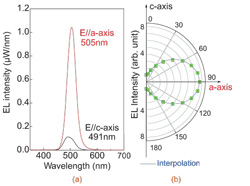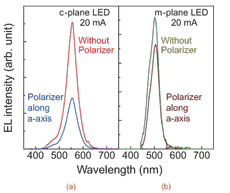
| Home | About Us | Contribute | Bookstore | Advertising | Subscribe for Free NOW! |
| News Archive | Features | Events | Recruitment | Directory |
News
22 October 2010
Polarized LED from Rensselaer and Kyma raises hope of more efficient displays
The Smart Lighting Engineering Research Center (ERC) at Rensselaer Polytechnic Institute (RPI) in Troy, NY and III-nitride materials provider Kyma Technologies Inc of Raleigh, NC, USA have used non-standard crystal growth directions to create a nitride semiconductor light-emitting diode with a polarization intensity ratio of 0.77 [Shi You et al, Appl. Phys. Express, vol3, p102103, 2010]. The researchers comment that this polarization intensity ratio is, to their knowledge, “the highest value obtained in top surface emission of any AlGaInN LED for wavelengths longer than 500nm from planar surface emission”.
Polarized LEDs could be used to make more efficient back-lighting units for liquid-crystal displays (LCDs). Nematic-phase liquid-crystal displays use polarized light to create images. The liquid-crystal material is put between a pair of polarizers. By varying the configuration of the liquid-crystal structure under an applied electric field, the light’s polarization can be shifted, thus modulating the transmission. If this set-up is driven by unpolarized light, then more than half the source’s power is thrown away by the first polarizer.
In the past couple of years, a number of research groups have been investigating nitride semiconductor LEDs grown in crystal directions different from the usual c-direction to improve performance, in particular to avoid wavelength shifts in the output light with drive current arising from the electric polarization fields that are directed in the c-direction in these structures. LEDs grown in non-polar and semi-polar directions also produce linearly polarized light.
The Rensselaer and Kyma researchers used gallium nitride (GaN) substrates that were 5mm x 10mm rectangular slices cut from free-standing bulk wafers (50mm diameter, up to 7mm thick) grown in the c-direction using hydride vapor phase epitaxy (HVPE). The study used substrates with surface m- and a-planes with off-cut angle less than 0.2°. Chemo-mechanical polishing was used to reduce the surface roughness to less than 0.5nm root-mean-square (rms) on both sides.
The LED structures were grown using metal-organic chemical vapor deposition (MOCVD). The multi-quantum well (MQW) light-emitting active regions consisted of five or eight pairs of indium gallium nitride (InGaN) wells and GaN barriers.
The indium fraction and well/barrier thicknesses were determined by combining information from x-ray diffraction (XRD) and high-resolution transmission electron microscopy (HR-TEM). The well thicknesses were in the range 3–4nm and the barriers were 20–25nm. The residual roughness of the MQW layers was determined by atomic force microscopy (AFM) – in the a-samples the value was 1.2-3.0nm rms and in the m-samples it was 0.2-0.5nm rms.
The n-type injection region was grown first on the substrate and consisted of 1μm of silicon-doped GaN. This was followed by the MQW sequence.
Photoluminescence (PL) studies show the m-plane MQW structures to have a polarization ratio that is about 30% higher than that for the a-plane samples. The researchers comment that current theory does not predict this, and suggest that the higher roughness values of the a-structures could be due to relaxation of the anisotropic strain effects and confinement that are thought to affect mainly the polarization of the output light through shifts and splitting of the valence band structure.
 Figure 1: (a) Polarization-resolved EL spectra of m-plane LED at 20mA. Emission polarized along the c-axis peaks with maximum intensity at 491nm, while emission polarized along the a-axis has a peak at 505nm. (b) EL intensity as a function of polarization angle together with interpolation of both main perpendicular components. At 0° and 180°, the polarizer is along the c-axis, and at 90° it is along the a-axis.
Figure 1: (a) Polarization-resolved EL spectra of m-plane LED at 20mA. Emission polarized along the c-axis peaks with maximum intensity at 491nm, while emission polarized along the a-axis has a peak at 505nm. (b) EL intensity as a function of polarization angle together with interpolation of both main perpendicular components. At 0° and 180°, the polarizer is along the c-axis, and at 90° it is along the a-axis.
The electroluminescence (EL) of one of the m-plane MQW structures was studied by adding a 15nm AlGaN electron-blocking layer and 120nm p-GaN injection layer to complete it into an LED. The polarization components along a- and c-axes were measured at an injection current of 20mA over a range of wavelengths (Figure 1).
The light polarization with the electric field parallel to the a-direction had a peak at 505nm (blue-green), while the c-polarization was much smaller (about 13% of the a-peak) and centered at a shorter wavelength 491nm. This shorter wavelength indicates an energy transition increase of ~70meV in this direction. Theoretical predictions based on splitting due to strain effects would give 40meV. The discrepancy could be due to quantum confinement effects.
The team expects that higher polarization could be achieved with proper packaging and suppression of die edge emission. The angular dependence of the polarization also fits the assumption of two intensities coming from separate components parallel to the a- and c-directions. The random contribution from light internally scattered within the LED is described as being ‘very low’. The researchers hope that moving to longer wavelengths (e.g. green at ~530nm or deep green at ~550nm) could increase the polarization ratio, particularly for m-plane structures.
 Figure 2: EL spectra of (a) c- and (b) m-plane LEDs with and without polarizer.
Figure 2: EL spectra of (a) c- and (b) m-plane LEDs with and without polarizer.
The effect of linear polarizers on the emissions from standard c-plane and m-plane LEDs were also compared (Figure 2). The c-plane emission was reduced by 57.7%, while the loss for the m-plane LED was only 25.4%. The use of polarized light from m-plane LEDs could enhance the output efficiency of polarized systems, potentially reducing power consumption. In the case of the 0.77 polarized light created in their latest experiments, the researchers say that the same polarized output power could be achieved with 44% less input light power, compared with a standard c-plane LED.
See related items:
Kyma and RPI search m-plane GaN for LED wavelength stability
![]() Search: Rensselaer Kyma Polarized LEDs MOCVD MQW InGaN GaN AlGaInN
Search: Rensselaer Kyma Polarized LEDs MOCVD MQW InGaN GaN AlGaInN
Visit: http://apex.jsap.jp
Visit: http://smartlighting.rpi.edu
Visit: www.kymatech.com
For more: Latest issue of Semiconductor Today
The author Mike Cooke is a freelance technology journalist who has worked in the semiconductor and advanced technology sectors since 1997.